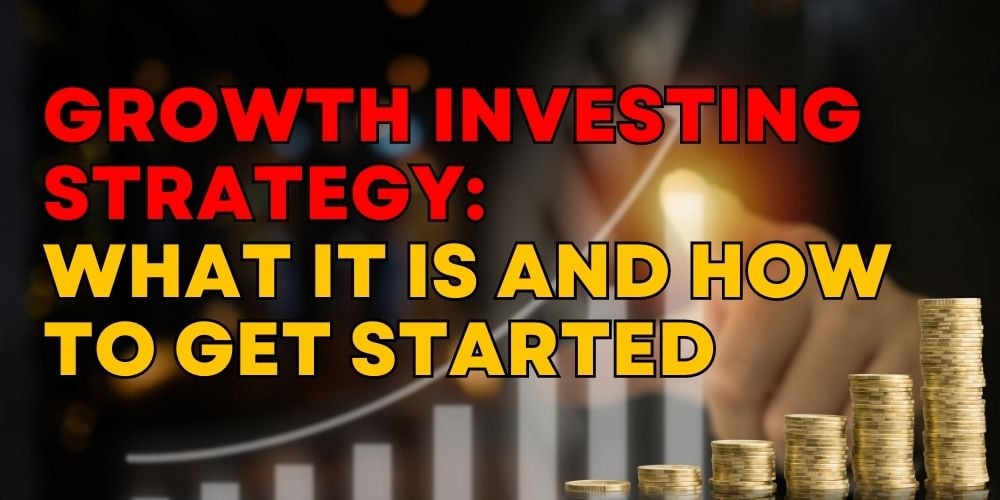Tired of watching your investments grow at a snail’s pace? Looking for a more aggressive approach to building your portfolio?
It’s time to consider a growth investing strategy and put money in companies that grow at above-market rates.
Growth investing historically performs better when interest rate risk is low, which is looking to be the case in the third and fourth quarters of 2023.
For example, growth stocks had a total return of 32% compared to the 24.9% generated by value stocks in 2021, making them more attractive than ever.
So, if you’ve just read our post on if The Motley Fool stock advisor works and are interested in learning more about growth investing, let’s get started!
What Is a Growth Investing Strategy?

Growth investing is a buy-and-hold investment strategy that helps you increase your wealth through capital appreciation.
In other words, you buy a stock at a low price and sell it for a profit when it rises in value—but you don’t buy just any stock.
You actually invest in stocks with attractive characteristics like a valuable brand, high sales, strong customer loyalty, and a high likelihood of expanding their market share.
A record of strong success enables these stocks to have high valuations (premium prices) compared to industry peers, which makes for a high get-in price with greater rewards in the future.
Pros and Cons of a Growth Investing Strategy
Let’s take a look at some of the advantages and disadvantages of adopting a growth investment strategy:
Pro: Chance of Higher Returns
Because they have high valuations and are a buy-and-hold investment option, growth investments have a greater potential to provide a fortune-creating return sometime in the future. However, you need to keep your investments for at least five years to build wealth.
Con: High Investment Risk
While the potential returns of growth investments can put dollar signs in your eyes, they also come with greater risk. The reason is that the stock market goes up and down, often 10% to 20% every year—and it has the potential to go even lower.
During times of downturns in the market, your investment may depreciate. If this happens, you won’t even get any dividends with growth investing. You only get returns when the investment prospers, and its earnings translate into higher stock prices.
If that’s the case, why should you even invest in growth stock? It’s simple: because keeping investments for a long period—even if they seesaw every year—smooths out these bumps and ensures high returns.
The large increase in stock price over the long-term could justify zero dividends.
Pro: No Huge Capital Investment Requirement
While growth stocks sell at a premium compared to market peers, you don’t have to put in thousands of dollars to buy them. Of course, you can if you want, but there’s no rush–you can easily start with several hundred dollars and move up over time.
Con: Low or No Returns in the Short-Term
As we said before, growth investing works best over time (it’s called buy-and-hold for a reason). If you’re expecting to get returns in one or two years, go for value or other stock options.
If you’re in for the long haul (at least five years), you’ll get the returns that made you see dollar signs in the first place.
How to Get Started with Growth Investing
Now that you know what a growth-investing strategy is, let’s dive into how you can start building your fortune by using it.
Cover Your Bases
If you’re thinking of investing, we assume you don’t need the money you’re putting into stocks at any time in the near future. If you do, don’t invest.
Instead, come back to the growth investing market once you’ve got enough cash to invest that you don’t need to touch for five to ten years. Why? Because you don’t want to sell stock midway, especially if it has depreciated.
Select the Type of Growth Investment
There are various growth investments with high potential returns you could put your cash into. Some examples include:
- Small-cap stocks, or stocks of companies with a marketing cap between $300 million to $2 billion
- Penny stocks, foreign currency, undeveloped land, options contracts, and private equity
- Technology stocks
- Healthcare stocks
You should look at a company’s increasing earnings per share, projected earnings, and return on equity when selecting growth stocks. If you need to Google all that, it might make more sense to take advice from a stock-picking program like The Motley Fool stock advisor.
The service focuses on stable companies with a proven track record of success and has been spot-on with its suggestions for the past eighteen years.
Some of their previous picks include HubSpot, Tesla, and Netflix—they generated above S&P 500 returns most years.
Whichever service you use, make sure you know who can legally give investment advice before you head down any recommended path.
Begin Investing
Once you’ve chosen your stock—either through personal analysis or by using an advisor—it’s time to start investing. That said, don’t go all in. Instead, if you’ve never made growth investments before, start with a small amount like 20% to 30% of your total investments.
In Conclusion
After you’ve gone through a few market up-and-downs and don’t panic anymore during times of volatility, you should allocate more funds to growth stocks and perhaps consider incorporating an ETF investment strategy into your portfolio.


 Tags:
Tags:










